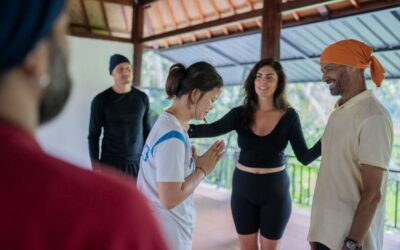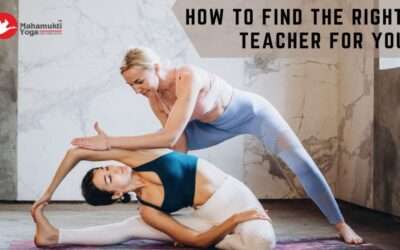Especially as a new yoga teacher, we feel the pressure of being a “perfect yogi” in order to set an example and inspire our students. We all have a certain mental image of what a perfect yoga teacher looks like: Someone who always radiates peace and calmness, never gets angry or loses their temper, executes every poses perfectly, never gets his/her sequences mixed up, can tell from the other side of the room which adjustment each student needs, looks ageless and has a defined, toned body and a low body fat percentage because of all the healthy food he/she eats. No matter what your definition of a perfect yoga teacher is, there are a few things that we should remember:
Yoga teacher are human beings too
When I first started yoga, I was blown away by my teachers: I was in awe of their strength, patience, and gratefulness that I found it hard to believe that we were both of the same species. I never actually expected to be able to do what they were doing, but I just kept on practising because it made me feel good and after years of consistent practice, I was able to do the same poses. That taught me that a teacher is a student with practice, experience, and the desire to share what they’ve learned. It seems obvious, but in my early yogi days, I found it hard to believe. They too struggled with poses, got annoyed, impatient, angry – that’s normal. There’s no harm in sharing that with your students, quite the contrary: Especially beginners might feel discouraged when they see you doing difficult poses effortlessly, leading them to think you were simply born a super yogi and that they’ll never be able to attain your level.
Remember how difficult some poses seemed to you at first (and how some of them still are!)? Try to share little anecdotes along the lines of “When I first tried this pose, I never thought I would be able to do it and got frustrated but remembered that wouldn’t get me anywhere. So, I tried to be patient with myself and my body and kept on trying, and a year later I was able to hold it.” This might give your students the courage to keep on trying, thereby making them feel like you know what they’re struggling with and encourages them to approach you after classes and share their struggles with you.
Yoga is not a competition
Modern yoga sometimes gets a competitive aspect when it is offered in fitness studios where some people might not care about breathing techniques, meditation, or savasana. However, this is nothing more than a misinterpretation. It is not a sport, it is a lifestyle, which focuses on honouring your body and accepting yourself the way you are. Especially in these times of social media and Photoshop, many people are very critical with their own body because they think they have to keep up with edited pictures of yogis with defined abs in bikinis/swimming trunks at the beach.
The “yoga body” as the definition for a long, lean, and muscular body is nothing more than a modern-day fitness term, a yoga body in the real sense of the word is everybody. Yoga should help you and your students understand their body and be kinder to themselves, and not to beat themselves up over something they’re still working on or that is completely unrelated to yoga.
Create a friendly atmosphere in your classes with smiles and without putting someone on the spot or comparing one student to another, as in “Mary, try lifting your leg a bit higher. Do you see Lucy’s leg? It’s so high up and straight!”. Never push your students or make them feel bad about things they can’t do yet. Of course, we have all peaked over to see how our neighbour gets into a pose, and there’s nothing wrong with that as long as we only need a demonstration to try it ourselves.
But as a teacher you shouldn’t point out to beginners that they should do things the way an advanced student is doing them, it is discouraging, not yet in their reach. This might make them feel inadequate and they might not come back to your class. Have no such expectations of your students and remind them that having expectations is attachment and therefore a cause of suffering. Tell them to let go of them and to focus on learning more about their body and how it feels during practice. You could also offer them a mantra like “I am enough” at the beginning of the class and suggest they’d come back to it whenever they can feel themselves getting frustrate or envious of another student.
A teacher is always a student
Don’t hesitate to tell your students what you’re struggling with. There’s no yoga teacher out there who perfectly masters every aspect of yoga, even though there might be some who try to convey that image. As a student, it is comforting to know that there are poses our teacher can’t do or that he/she gets impatient sometimes. It gives us hope and inspiration for our own journey, and that’s what we seek from a teacher – assistance and encouragement, not distance and illusion.
You should see your students first and foremost as fellow yogis. You might have more experience and assist them at executing poses, but don’t build a wall between student and teacher. The best reminder for your students to treat your body and yourself with kindness is to set an example: “If your hand doesn’t reach the floor, use a block like I am doing.” Or “When your mind wanders during the meditation just bring it back, it happens to all of us.”
I know yoga teachers that look around nervously when queuing up for ice cream or ordering a pizza: “I hope none of my students sees me here!” You’re not doing anything wrong if you’re having sweets or unhealthy food from time to time, what’s wrong is the attitude of wanting your students to think you’d never do something like this. It’s okay to feel discouraged, down, and uninspired sometimes, just don’t let the imagines and posts of other yoga teacher fool you: Nobody looks always radiant and feels great 24/7. Let your students know that you have flaws too and that you’re all on this journey together.
Don’t be afraid to be who you are
The most authentic and inspiring yoga teachers are the ones not afraid to show their real selves, even if that means revealing their imperfections sometimes. I have met yoga teachers that lived a very “non-yogic” lifestyle before discovering yoga and it helped them feel more balanced and happier. Most of them have deep gratitude for yoga and its transformational power because they know what it’s like to be stress and anxious most of the time, and how good it feels to take things to step by step and to learn that all there is in the present.
So, don’t hide who you were before becoming a yogi – nobody came out of their mother’s womb seated in a lotus pose. Strive for authenticity instead: Show character! You want your students to notice the difference between your classes and those of someone else. You want your students to come back because they find you to be extra patient, motivational, funny…something that makes you stand out – without forcing it, of course. And there’s no need to: I remember my Yoga Teacher Training and how I and three other yogis had to come up with a class for everyone else. Whenever one of us complete teaching and the next one continue the class, the atmosphere will change. Some people are just more suited for calmer styles of yoga-like Yin or Yoga Nidra, while others need powerful Vinyasas to feel calm and grounded.
Teach what you love and what you feel comfortable teaching. You might feel tempted to teach a certain style you’re not very familiar with or not passionate about, simply because a yoga studio is looking for someone to teach this style. Real enthusiasm is palpable – disinterest is, too. So, accept your character, teaching style, and teaching preferences, and I am sure there will be people who enjoy your style and come back to your classes!
Get in Touch…
Addresss: Yoga Niketan Trust, Muni-Ki-Reti,P.O. Shivanand Nagar, Rishikesh
Contact no. : +91-95362 00770
Email Id: mahamuktiyoga@gmail.com
Website: https://www.mahamuktiyoga.com/
Yoga Teacher Training in Rishikesh | 200 Hour Yoga Teacher Training in Rishikesh | Yoga in Rishikesh | Best Yoga Teacher Training in Rishikesh
Related Blogs
Top 10 Beachfront Yoga Retreats to Visit in Goa This Season
Experience the fusion of yoga, nature, and the calming sea on Goa’s most beautiful beaches. Here’s your 2025 guide to the top beachfront yoga retreats in Goa. 1. Bamboo Yoga Retreat, Polem Beach (South Goa) Eco-huts right on the beach Hatha, Vinyasa, Yin,...
Why Goa Became India’s Top Destination for Beach Yoga, TTCs & Mindful Festivals in 2025
Why Goa Became India’s Top Destination for Beach Yoga, TTCs & Mindful Festivals in 2025 In 2025, Goa has emerged as India’s most sought-after destination for yoga lovers, wellness seekers, and spiritual travelers. Known for its serene beaches, tropical climate,...
Several Factors Considered While Opting Professional Yoga Instructor
You need to know what to look for. Yoga alliance membership cost since there is no universal Certification program for yoga teachers.








